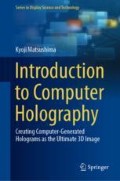Abstract
In this chapter, we discuss a technique to reconstruct real objects by HD-CGHs like traditional optical holography. The object field emitted by a subject is recorded by an image sensor instead of photo-sensitive chemicals unlike traditional holography. The captured object field is arranged in a virtual 3D scene like computer holography mentioned so far, and is optically reconstructed by the HD-CGH. We start from the capturing technique using phase-shifting synthetic aperture lensless-Fourier digital holography, and then proceed to occlusion processing of the physical object and embedding the captured field into a virtual 3D scene. A topic of digital resizing of the captured field is also discussed in this chapter.
Access this chapter
Tax calculation will be finalised at checkout
Purchases are for personal use only
Notes
- 1.
The word “digital holography” is used in a broad sense in many fields and not restricted to digitized recording of holograms in practice.
- 2.
The word “numerical reconstruction” is often used in DH instead of simulated reconstruction.
- 3.
Since \(g_{\mathrm {obj}}(x, y; -d_\mathrm {R})\) is obtained by the inverse Fourier transform of the both sides of (14.18), “inverse Fourier transform” seems to be more exact expression than simple “Fourier transform”. In this case, however, we can choose forward Fourier transform as well as inverse Fourier transform by definition of u and v.
- 4.
The minimum integers that is a power of 2 and more than sensor pixels are commonly chosen for \(M_0\) and \(N_0\).
- 5.
Because the whole sensor pixels are used in the end of the sensor scan, the number of effective pixels is estimated at 7,332 (\({=} 1{,}333 \times 4 + 2{,}000\))
- 6.
Perceptive readers may notice the handle of the cup turning to the opposite direction!
- 7.
The bees may look 2D objects rather than 3D objects because the model and its orientation are two dimensional. This is because we could not process self-occlusion of the model properly when Bear II was created. The switch-back technique was invented later.
- 8.
Left and right are swapped by mistake in the corresponding figure in [63].
- 9.
In this case, resampling can be performed by just thinning out sample points.
- 10.
This means that we assume the resized field has the same sampling interval as that in the original field and obtain the maximum diffraction area at the position of the intermediate plane.
Author information
Authors and Affiliations
Corresponding author
Rights and permissions
Copyright information
© 2020 Springer Nature Switzerland AG
About this chapter
Cite this chapter
Matsushima, K. (2020). Digitized Holography. In: Introduction to Computer Holography. Series in Display Science and Technology. Springer, Cham. https://doi.org/10.1007/978-3-030-38435-7_14
Download citation
DOI: https://doi.org/10.1007/978-3-030-38435-7_14
Published:
Publisher Name: Springer, Cham
Print ISBN: 978-3-030-38434-0
Online ISBN: 978-3-030-38435-7
eBook Packages: Physics and AstronomyPhysics and Astronomy (R0)

